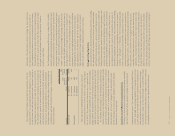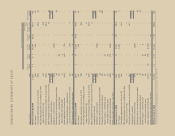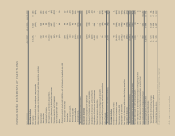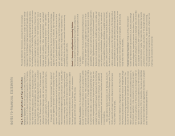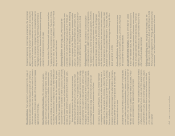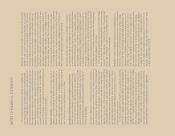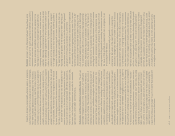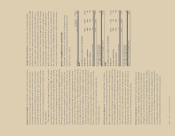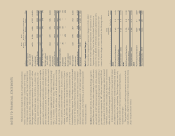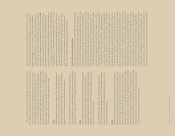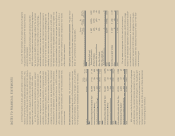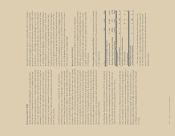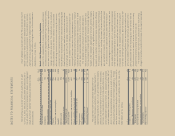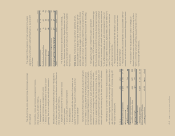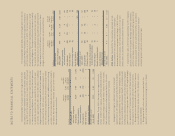Sara Lee 2011 Annual Report Download - page 88
Download and view the complete annual report
Please find page 88 of the 2011 Sara Lee annual report below. You can navigate through the pages in the report by either clicking on the pages listed below, or by using the keyword search tool below to find specific information within the annual report.
NOTES TO FINANCIAL STATEMENTS
Businesses Held for Sale
In order for a business to be classified
as held for sale, several criteria must be achieved. These criteria
include, among others, an active program to market the business
and locate a buyer, as well as the probable disposition of the busi-
ness within one year. Upon being classified as held for sale, the
recoverability of the carrying value of a business must be assessed.
Evaluating the recoverability of the assets of a business classified
as held for sale follows a defined order in which property and intan-
gible assets subject to amortization are considered only after the
recoverability of goodwill, intangible assets not subject to amortiza-
tion and other assets are assessed. After the valuation process
is completed, the held for sale business is reported at the lower
of its carrying value or fair value less cost to sell and no additional
depreciation expense is recognized related to property. The carrying
value of a held for sale business includes the portion of the cumu-
lative translation adjustment related to the operation.
Businesses Held for Use
If a decision to dispose of a business
is made and the held for sale criteria are not met, the business
is considered held for use and its assets are evaluated for recover-
ability in the following order: assets other than goodwill; property
and intangibles subject to amortization; and finally, goodwill. In eval-
uating the recoverability of property and intangible assets subject
to amortization, in a held for use business, the carrying value of
the business is first compared to the sum of the undiscounted cash
flows expected to result from the use and eventual disposition of the
operation. If the carrying value exceeds the undiscounted expected
cash flows, then an impairment is recognized if the carrying value
of the business exceeds its fair value.
There are inherent judgments and estimates used in determining
future cash flows and it is possible that additional impairment charges
may occur in future periods. In addition, the sale of a business can
result in the recognition of a gain or loss that differs from that
anticipated prior to the closing date.
Property Property is stated at historical cost and depreciation is
computed using the straight-line method over the lives of the assets.
Machinery and equipment are depreciated over periods ranging
from 3 to 25 years and buildings and building improvements over
periods of up to 40 years. Additions and improvements that sub-
stantially extend the useful life of a particular asset and interest
costs incurred during the construction period of major properties
are capitalized. Leasehold improvements are capitalized and amor-
tized over the shorter of the remaining lease term or remaining
economic useful life. Repairs and maintenance costs are charged
to expense. Upon sale or disposition of a property element, the
cost and related accumulated depreciation are removed from the
accounts. Capitalized interest was $11 million in 2011, $10 million
in 2010 and $10 million in 2009.
Prior to 2011, the corporation’s shipping and handling costs
were being recognized in the Selling, general and administrative
expenses (SG&A) line of the Consolidated Income Statement with
the exception of the North American Foodservice and International
Beverage business segments, where a portion of these costs were
being recognized in Cost of sales. Beginning in 2011, the corpora-
tion is now reporting all shipping and handling costs incurred after
a product is considered complete and ready for sale in SG&A. The
impact of this change is considered to be immaterial to the consoli-
dated annual financial statements.
Inventory Valuation Inventories are stated at the lower of cost or
market. Cost is determined by the first-in, first-out (FIFO) method.
Rebates, discounts and other cash consideration received from a
vendor related to inventory purchases is reflected as a reduction in
the cost of the related inventory item, and is therefore, reflected in
cost of sales when the related inventory item is sold.
Recognition and Reporting of Planned Business Dispositions
When a decision to dispose of a business component is made,
it is necessary to determine how the results will be presented
within the financial statements and whether the net assets of that
business are recoverable. The following summarizes the significant
accounting policies and judgments associated with a decision to
dispose of a business.
Discontinued Operations
A discontinued operation is a business
component that meets several criteria. First, it must be possible to
clearly distinguish the operations and cash flows of the component
from other portions of the business. Second, the operations need
to have been sold or classified as held for sale. Finally, after the
disposal, the cash flows of the component must be eliminated from
continuing operations and the corporation may not have any signifi-
cant continuing involvement in the business. Significant judgments
are involved in determining whether a business component meets
the criteria for discontinued operation reporting and the period in
which these criteria are met.
If a business component is reported as a discontinued operation,
the results of operations through the date of sale are presented on
a separate line of the income statement. Interest on corporate level
debt is not allocated to discontinued operations. Any gain or loss
recognized upon the disposition of a discontinued operation is also
reported on a separate line of the income statement. Prior to dispo-
sition, the assets and liabilities of discontinued operations are
aggregated and reported on separate lines of the balance sheet.
Gains and losses related to the sale of business components
that do not meet the discontinued operation criteria are reported in
continuing operations and separately disclosed, if significant.



